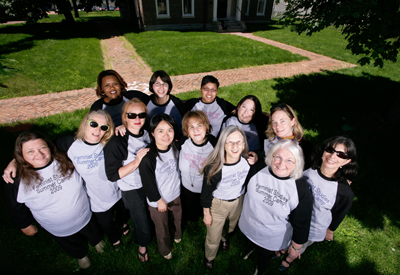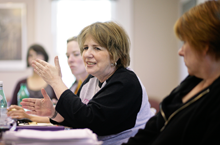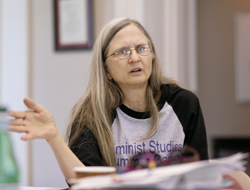by Rebekah Tilley
photos by Shaun Ring and Richie Wireman
In a certain main academic office on campus is a picture of a half-undressed young woman, breast exposed, smoking, with cigarette butts littered around her enticingly draped bed. It is the cover of a pamphlet dated 1905 that loudly asks the loaded question, “Is College Bad for Girls?” and insinuates that a college education leads young women to such deadly sins as “flirting” and “speaking to male students without Proper Introduction or Chaperone.” The pamphlet cover, now a relic in the newly created Department of Gender and Women’s Studies, is a visual reminder of how far women in the academy have come in the last 100 years.
Women’s Studies as an academic discipline was born in the 1970s and came to the University of Kentucky in the 1980s, thanks largely to the efforts of Nancy Dye, then Assistant Dean of Arts & Sciences and now President of Oberlin College, who was looking for a way to support faculty with teaching and research interests in this emerging field. What was then the Women’s Studies Program formally began in 1989, and by 1994 the Program had a lively special topics undergraduate major and began awarding Graduate Certificates. “Over the years we began to function more and more like a department in that our courses drew lots of students, we had many connections with other departments across campus, and we were very much a central part of campus life,” said Susan Bordo, who served as interim director of the program from 2008-09.
Birth of a Department
For many years scholars studying topics in Gender and Women’s Studies were fragmented across the disciplines, much like history and English scholars were in the 19th century. But intellectually, more and more scholars were in fact crossing disciplinary boundaries in their work. “There comes a time when areas that people have been working in, in a very dispersed way, develop the intellectual coherence, influence and scholarly heft to become fields in their own right. And that’s where Gender and Women’s Studies is now. It has become a powerful, interdisciplinary field,” says Bordo. “Becoming a department allows students to pursue the study of gender in a way that honors the contributions of many disciplines, and that seeks points of integration among them.”
 The journey toward department status formally began in 2002, when then College of Arts & Sciences former Dean Steve Hoch made transforming the Gender and Women’s Studies Program to a department part of his strategic plan for the college. By then, the Women’s Studies Program had revised its name to “Gender and Women’s Studies,” a change which reflects the broader, more inclusive approach of the GWS faculty. Seven years later, the transformation is accomplished, and Gender and Women’s Studies officially became a department in June 2009. Beginning fall of 2009, the department will begin offering bachelors degrees, and graduate degrees will soon follow.
The journey toward department status formally began in 2002, when then College of Arts & Sciences former Dean Steve Hoch made transforming the Gender and Women’s Studies Program to a department part of his strategic plan for the college. By then, the Women’s Studies Program had revised its name to “Gender and Women’s Studies,” a change which reflects the broader, more inclusive approach of the GWS faculty. Seven years later, the transformation is accomplished, and Gender and Women’s Studies officially became a department in June 2009. Beginning fall of 2009, the department will begin offering bachelors degrees, and graduate degrees will soon follow.
Department status allows for the hiring and tenuring of top scholars who have made Gender and Women’s Studies their life work. “The movement from a program to a department is a way of shoring up institutional commitment to a form of inquiry and to the faculty and students who focus on that inquiry,” said Joan Callahan, director of the program from 1996 to 2007. “Having department status for Gender and Women’s Studies helps to make sure that faculty whose main interests are interdisciplinary have a tenure home that prizes that kind of work.”
Why is a tenure home so important for faculty? “We have seen fantastic scholars struggle because they are doing work that appears in journals that members of their department are unfamiliar with,” Bordo explained. “They publish in top-notch journals, but no one in their department has read them because they are gender studies journals. Those people are going to have trouble when it hits tenure time.” “In a department, consciously established to recognize such work,” said Callahan, “the question of the validity of the area of research simply doesn’t arise. The kinds of trouble Bordo alludes to completely go away, and tenure consideration can focus, as it should, on the quality of a faculty member’s work.”
A Community Like Few Others
“The GWS community at UK is unlike any academic department I have been a part of,” said Lisa Schroot, a doctoral candidate in English who completed a Graduate Certificate in Gender and Women’s Studies. “Department meetings are relaxed, comfortable, and yet productive. Faculty members are always willing to meet with students, and to provide guidance to students, even those they have not had in class. And social functions always include children, which gives the program a family-like quality that is all too rare in academia. In a word, the department community is supportive.”
The core faculty of the Department of Gender and Women’s Studies are housed in Breckenridge Hall next door to the Funkhouser Building, which provides the physical space for the community and scholarly collaboration that has become the trademark of the UK Department of Gender and Women’s Studies. It’s a quality that the department’s first chairperson, Patricia Cooper, plans to continue to nurture as the department moves forward. “One of the most important things is creating a department that is an exciting and enjoyable place to be. I really want students to feel welcome. We have so much to offer in the way of new courses, global perspectives, and cutting edge scholarship that students will find it to be an ideal intellectual environment.”

This past May the GWS faculty community came together to collectively create a curriculum for a new class to be offered for the first time in fall 2010 on the Transnational History of Feminist Thought. “Planning that course was a collaborative and exciting effort,” said Bordo. And in a move that demonstrates the department’s entrepreneurial spirit, Bordo submitted a proposal to University of California Press to develop a textbook from the course. The advance the department received went toward compensating faculty members for their summer service time, and ultimately, the effort will conclude with a textbook produced by the UK Department of Gender and Women’s Studies. “It will be become, hopefully, not just the textbook that we use, but that will be used elsewhere too,” said Bordo.
BA and Beyond
So what does one do with a degree in Gender and Women’s Studies?
Bordo smiled, “The question used to be, what are you going to do with a degree in English? It’s not so much that there are very particular things that you can do with a degree in English. It has more to do with the person you become, and the skills you develop, and the perspective you have, that whatever area you go into is going to be impressive. In the 21st century, somebody who is comfortable talking about cultural difference, someone who understands racial dynamics, who has worked in an interdisciplinary way, is someone who can bring something really appealing to any number of jobs.”
Plans are well underway for the department to begin offering master’s and doctoral degrees in Gender and Women’s Studies in the near future. There are still only a handful of colleges and universities offering graduate-level degrees in the field, giving the University of Kentucky the opportunity to be ahead of the curve in addition to enriching its undergraduate program with everything that a graduate program provides.
 “Implementing a Ph.D. program will help us attract new faculty to the department and will help keep us on our toes with fresh ideas and lively discussions,” said Cooper. “Graduate students can be great mentors for undergraduates, and their energy and enthusiasm will affect all of us in positive ways. I really see the undergraduate and graduate programs working together. Further, a Ph.D. program will help us establish our reputation as a first-rate Gender and Women’s Studies program nationally and internationally.”
“Implementing a Ph.D. program will help us attract new faculty to the department and will help keep us on our toes with fresh ideas and lively discussions,” said Cooper. “Graduate students can be great mentors for undergraduates, and their energy and enthusiasm will affect all of us in positive ways. I really see the undergraduate and graduate programs working together. Further, a Ph.D. program will help us establish our reputation as a first-rate Gender and Women’s Studies program nationally and internationally.”
“Frankly, I think we’re going to put this school on the map,” said Bordo.
Not So Radical Anymore
Professor Emerita of History at San Francisco State University and noted feminist scholar Marilyn J. Boxer commented recently that in the late 1960s, “merely to assert that women should be studied was a radical act.” Now programs in Gender and Women’s Studies are becoming decidedly mainstream and recognized as a necessary component of a well-rounded liberal arts program offering. Throughout the application process toward becoming a department, Bordo said that support from the College of Arts & Sciences and UK as a whole “has been absolutely fantastic.”
“Gender and women’s studies departments have created and filled an important intellectual niche on American campuses, and they continue today to be energetic communities that make major scholarly, teaching, and cultural contributions to these campuses,” said Philip Harling, Interim Dean of the UK College of Arts & Sciences. “Transforming the Gender and Women’s Studies Program here into a new A&S department makes not just scholarly, pedagogical, and administrative sense. It also makes strategic sense.”
“The story of the department is of the program's progress through all these different hands, with the hard work and dedication of dozens of faculty over roughly 30 years. Each director added something new that made the program of greater and greater service to the university and the community,” said Callahan, echoing many others interviewed for this story.
 From those who got the fledgling program off the ground, built the community, shepherded it through administrative hurdles, and provided the public face and persuasive voice that achieved department status, there is a shared sense of history among those that tell the story of this department. “I really do feel like we're standing on the shoulders of amazing foremothers and it is a beautiful sight,” said Cooper. “I'm still part historian at heart so this sense of connection and continuity over decades really touches me and fills me with pride and gratitude.”
From those who got the fledgling program off the ground, built the community, shepherded it through administrative hurdles, and provided the public face and persuasive voice that achieved department status, there is a shared sense of history among those that tell the story of this department. “I really do feel like we're standing on the shoulders of amazing foremothers and it is a beautiful sight,” said Cooper. “I'm still part historian at heart so this sense of connection and continuity over decades really touches me and fills me with pride and gratitude.”
